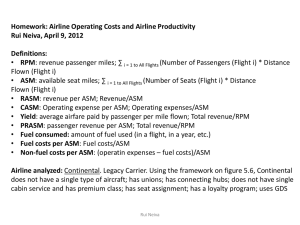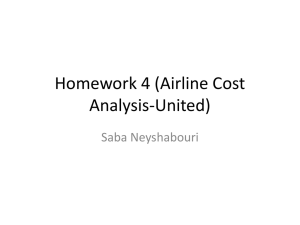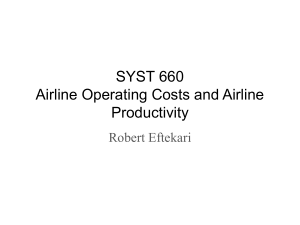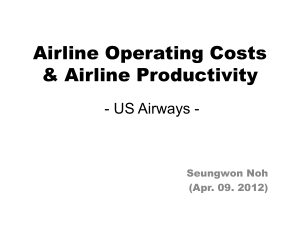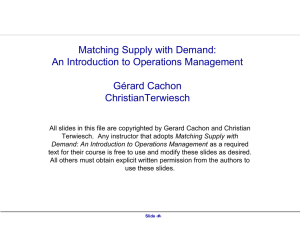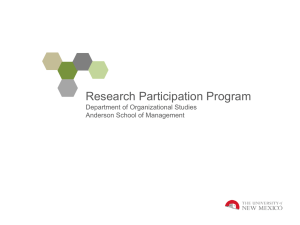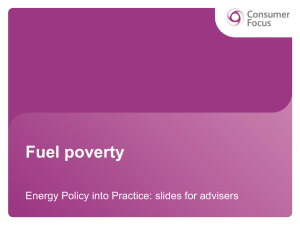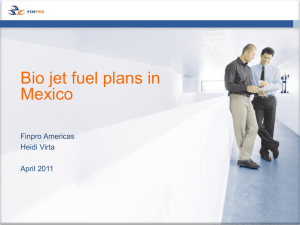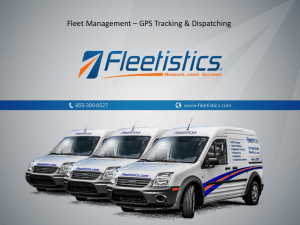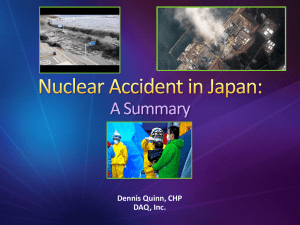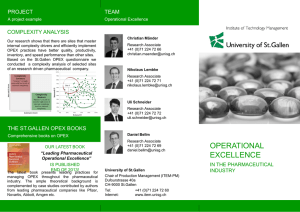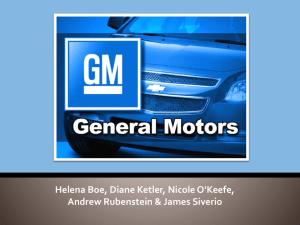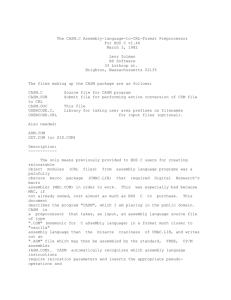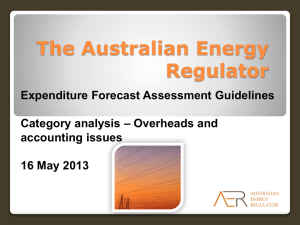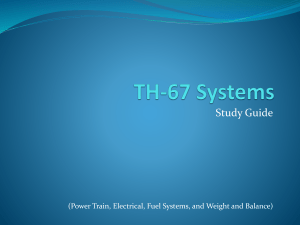Delta Air Lines Cost and Productivity Analysis
advertisement
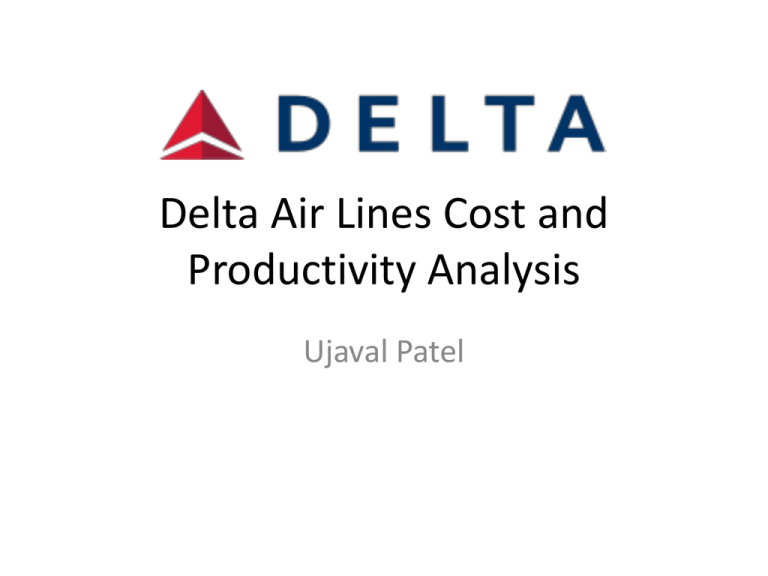
Delta Air Lines Cost and Productivity Analysis Ujaval Patel Airline Information • Delta is considered a legacy carrier. • It has: – A heterogeneous fleet mix – Fleet hubs (Dom: ATL, DTW, MSP, LGA, SLC, JFK, CVG, MEM; Int: CDG, NRT, AMS) – Small percentage of unionized workers – Categorized seating classes – Seat assignments – Frequent flyer program – GDS Definitions • RPM –Revenue Passenger Mile – One revenue paying passenger transported one mile. ∑ i = 1 to All Flights (# of revenue passengers * # of miles traveled) • ASMs – Available Seat Miles – One available seat flown 1 mile. ∑ i = 1 to All Flights (# of seats on flight * # of miles flown) • RASM – Revenue Per Average Seat Mile –Revenue made from each seat mile offered = Operating Revenue/ASMs • CASM – Cost Per Average Seat Mile -Cost to operate each seat per mile offered = Operating costs /ASMs • Yield – measure of the average fare paid by all passengers per mile flown. = Total Operating Revenue/ # Revenue Passenger Miles = Load Factor * Yield • PRASM - passenger revenue per ASM. = Total passenger revenue/ASM • Fuel Consumed – Total volume of fuel used • Fuel Costs per ASM = Fuel Cost / ASM • Non-Fuel Costs per ASM = (Operating Expenses – Fuel Costs)/ASM 60,000,000 RSM, ASM, and Load Factor Comparison 100.00% 90.00% 55,000,000 50,000,000 70.00% 60.00% 45,000,000 50.00% 40,000,000 40.00% Load Factor (%) Distance in thousands 80.00% 30.00% 35,000,000 20.00% 30,000,000 10.00% 25,000,000 0.00% 2006 2007 2008 2009 2010 2011 2012 Q3 Years • The trends shown represent the rise in 3rd Quarter RPMs and ASMs. • 2010 showed a great increase in both RPMs and ASMs, though the trend seems to be tapering off a little, due to the merger with Northwest. •The load factor has gradually increased from ~80% to ~90% in 6 years. RPM ASM Load Factor Operating Revenue, Operating Expenses, and Income Before Taxes Amount in Thousands of Dollars 12,000,000 10,000,000 8,000,000 Operating Revenue 6,000,000 Operating Expenses 4,000,000 Income Before Taxes 2,000,000 0 2006 2007 2008 2009 2010 2011 2012 Q3 Years • The 3rd quarter is prime summer traveling season and sees the most RPMs and ASMs. • 2008 and 2009 signal the high cost to keep up profits up even during the summer. • The merger in 2010 saw expenses and revenues dramatically rise, and this has led to higher Q3 profits. RASM, CASM, Yield, PRASM $0.25 $0.20 $0.15 RASM CASM $0.10 Yield PRASM $0.05 $2006 2007 2008 2009 2010 2011 2012 Q3 Years • By 2009 the yeild was dropping and CASM was seeing a rise. This was cutting into profits. •With the merger in 2010, the yeild was climbing again and CASM was dropping . Though, currently CASM is back at 2009 levels. Fuel OPEX, Non-Fuel OPEX, Fuel Consumption 900,000 800,000 Costs (thousands of dollars) 6,000,000 700,000 5,000,000 600,000 4,000,000 500,000 3,000,000 400,000 300,000 2,000,000 200,000 1,000,000 100,000 0 Fuel Consumption (thousands of gallons) 7,000,000 Fuel OPEX Non-Fuel OPEX Fuel Consumption 0 2006 2007 2008 2009 2010 2011 2012 Q3 Years • The summer months tend to have higher than average fuel prices. • 2008 saw a price spike in fuel prices and thus there was a spike in Fuel OPEX. • With the merger Fuel OPEX has increased steadily, while Non-Fuel OPEX and fuel consumption has remained relatively steady. $0.14 $4.00 $0.12 $3.50 $3.00 OPEX per ASM $0.10 $2.50 $0.08 $2.00 $0.06 $1.50 $0.04 $1.00 $0.02 Average Fuel Cost per Gallon OPEX ASMs and Fuel Cost Fuel OPEX per ASM Non-Fuel OPEX per ASM Fuel Cost Per Gallon $0.50 $- $0.00 2006 2007 2008 2009 2010 2011 2012 Q3 Years • The price of fuel saw a spike in 2008 and the price dropped back down in 2009, but it has steadily creeped up over the past 3 years. • As expected Fuel OPEX per ASM closely follows the trend of fuel cost. Where as Non-Fuel OPEX has remained fairly stable. Final Thoughts • Fuel prices and dropping profits in Q3 were probably an indicator of two years of lost profits at Delta in 2008 and 2009. • With the merger in 2010 with Northwest fuel expenses did rise as the fleet size increased. • Additionally, airline expenses rose to handle the larger company that was formed. • With an increased market share and a drop in CASM after the merger profits rose, and have steadily risen since.
